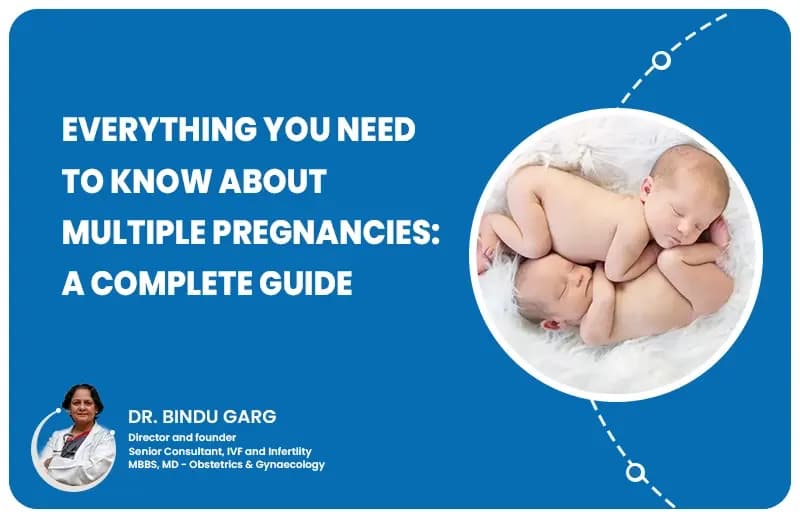
Everything You Need to Know About Multiple Pregnancies: A Complete Guide
Are you curious about multiple pregnancies and want to understand how they happen, their unique challenges, and how they are managed for the health of both mother and babies? Multiple pregnancies, which involve carrying more than one fetus at a time, have their own unique aspects that every prospective parent should be aware of.
In this detailed blog, we'll tell you about the causes of multiple pregnancies, the different types, and what to expect in terms of prenatal care and potential complications. By reading this guide, you'll gain a clear understanding of what happens in multiple pregnancies, why they require special medical attention, and how modern healthcare supports healthy outcomes.
Whether you are researching this topic out of personal interest or because it affects you or a loved one, this article provides practical insight and reassurance for navigating the journey of multiple pregnancies.
What Are Multiple Pregnancies?
Multiple pregnancies refer to pregnancies in which more than one fetus develops in the womb at the same time. The most common types are:
- Twins: Two babies are developing together.
- Triplets: Three babies are developing at the same time.
- Higher-order multiples: Four or more babies. This is rare and usually requires special medical attention.
These pregnancies happen in different ways. Some happen naturally, while others may result from fertility treatments, such as in-vitro fertilization (IVF).
How Do Multiple Pregnancies Happen?
Multiple pregnancies occur when more than one egg is fertilized during ovulation (resulting in twins or multiples) or when one fertilized egg splits into two or more embryos (resulting in identical twins or multiples).
Here's a description of the two main types:
- Fraternal Twins (Dizygotic Twins): Two separate eggs are fertilized by two separate sperm cells. These babies have their own placenta and may or may not be of the same sex.
- Identical Twins (Monozygotic Twins): One fertilized egg splits into two embryos. These twins share the same placenta and are genetically identical, which means they will look alike and share the same sex.
The chances of having twins, triplets or more are increasing thanks to advanced fertility treatments. However, natural multiple pregnancies are still relatively uncommon.
How Are Multiple Pregnancies Diagnosed?
The most common way to diagnose a multiple pregnancy is through an ultrasound. This imaging technique allows the doctor to see the babies in the womb. Early ultrasounds can usually confirm if you are carrying more than one baby and provide essential information, such as how many babies there are and how far along your pregnancy is.
Early Signs You Might Be Pregnant with Multiples
Some of the early symptoms of multiple pregnancy include the following:
- Higher than normal levels of pregnancy hormones: This can cause symptoms such as morning sickness, fatigue, and changes in appetite to be more noticeable.
- Rapid weight gain: Women giving birth to twins or more babies may notice rapid weight gain in the early stages.
- Bigger belly: Since your body can accommodate more than one baby, your belly may grow more rapidly than with a single pregnancy.
However, these signs are not definitive, and the only way to confirm a multiple pregnancy is through medical tests.
Risks Associated with Multiple Pregnancies
While multiple pregnancies can be exciting, they do come with certain risks that are not typically associated with single pregnancies. It's important to be aware of these risks so you can take the necessary steps to protect your health and the health of your babies. Some of the most common risks include:
1. Premature Birth
The more babies you give birth to, the higher the chances of premature delivery. Babies born prematurely may face challenges such as low birth weight, breathing problems, and other complications.
2. Gestational Diabetes
Women who have more than one pregnancy have a higher risk of developing gestational diabetes. This condition can affect the growth of babies and cause complications during delivery.
3. Pre-Eclampsia
This is a complication of pregnancy that involves high blood pressure and damage to organs such as the kidneys. Women who give birth to multiple babies have an increased risk of developing pre-eclampsia, which may require premature delivery.
4. Placental Problems
Multiple pregnancies increase the risk of problems such as placenta previa (where the placenta covers the cervix) or placental abruption (when the placenta separates prematurely). These can cause bleeding and other serious problems.
5. Increased Risk of Cesarean Delivery
Many women who give birth to multiple babies have to have a caesarean section (C-section) because of the higher chance of complications during delivery. If the doctor feels a C-section will be safe for both you and your babies, it can be planned in advance.
6. Low Birth Weight
Babies born from multiple pregnancies tend to have low birth weight, especially if they are born prematurely. A low birth weight increases the chance of needing extra medical care after birth.
How to Take Care of Yourself During a Multiple Pregnancy
If you're expecting twins, triplets or more, you may be nervous, but taking good care of yourself is one of the most important things you can do for your babies. Here are some tips to ensure a healthy pregnancy:
1. Attend Regular Prenatal Checkups
It is very important to visit your obstetrician regularly. These check-ups help keep track of your babies' development and catch any potential problems early. Ultrasounds and blood tests will be scheduled more frequently to monitor the babies' health.
2. Follow a Healthy Diet
A nutritious diet is very important during a multiple pregnancy. You will need extra calories, protein and other nutrients. A diet rich in fruits, vegetables, lean proteins, whole grains and plenty of water will keep you energized and help ensure the proper development of your babies.
3. Rest as Much as Possible
Pregnancy can be very physically demanding, and carrying multiple babies can be even more exhausting. Make sure you get enough rest and take breaks when needed. Don't hesitate to ask family members for help, especially as your pregnancy progresses.
4. Exercise with Caution
While exercise is beneficial for most pregnant women, you should be more cautious if you are pregnant with multiples. Low-impact activities such as walking or swimming can help maintain your fitness and reduce discomfort. Always consult your doctor before starting any new exercise routine.
5. Watch for Warning Signs
Contact your doctor immediately if you experience any of the following symptoms:
- Severe abdominal pain
- Heavy bleeding
- Sudden swelling of your hands or face
- Difficulty breathing or chest pain
- Severe headaches or vision changes
These could be signs of complications that need immediate attention.
6. Stay Hydrated
It's important to keep your body well-hydrated during a multiple pregnancy. Dehydration can lead to preterm labor, so it's important to drink plenty of water throughout the day.
Preparing for Labor and Delivery
When it comes time for labor, you'll want to be prepared. Women with multiple pregnancies often go into labor earlier than women with only one baby, so it's important to have everything ready ahead of time.
- Consider a Birth Plan: Discuss your preferences for labor and delivery with your doctor or midwife. Many women with multiple pregnancies have to have a C-section, but it's important to know all of your options.
- Be Ready for NICU: Babies born from multiple pregnancies, especially those born prematurely, may need extra care in a neonatal intensive care unit (NICU). It's a good idea to be mentally prepared for this possibility.
- Prepare for Postpartum Care: It can take time to recover from giving birth to more than one child. Support from family and friends can make this transition easier.
Frequently Asked Questions (FAQs)
Q1. What is the difference between identical and fraternal twins?
Identical twins arise from a single egg, while fraternal twins arise from two separate eggs.
Q2. How early can multiple pregnancies be detected?
Ultrasound can usually detect multiple babies at 6 to 8 weeks of pregnancy.
Q3. Are multiple pregnancies always high-risk?
Not all cases are high-risk, but many require close monitoring to prevent complications.
Q4. What are the chances of having multiples with IVF?
IVF increases the chance of multiple embryos, because often more than one embryo is transferred.
Q5. How do I manage the extra costs of a multiple pregnancy?
Many parents budget carefully, use second-hand items, and seek out community resources for assistance.
Q6. What support is available for parents of multiple?
Support groups, online communities, and friends and family can provide much-needed help and advice.
Conclusion
Multiple pregnancies can be an exciting but challenging experience. With the right preparation, medical care and support, you can ensure a healthy pregnancy for both you and your babies. If you are expecting twins, triplets or more, it is important to stay informed and take proactive steps to manage your health throughout your pregnancy. Always work closely with your healthcare provider, follow their advice and take time to rest and take care of yourself. Dr. Bindu Garg and her team are there to guide you every step of the way, providing expert care and support for a safe and healthy pregnancy. If you are expecting multiples, do not hesitate to contact us for personalized advice and care.
Content Created By:

CyberBizz Technologies
Team - Content Curator